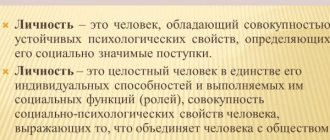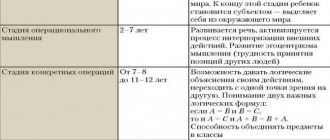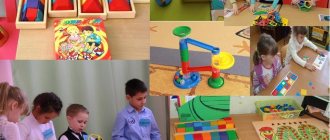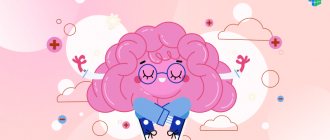Individual characteristics of thinking
Individual characteristics of thinking in different people are manifested primarily in the fact that they have different relationships between different and complementary types and forms of mental activity (visual-figurative, visual-effective and conceptual (abstract) thinking). Individual characteristics of thinking also include other qualities of cognitive activity:
- Independence of thinking,
- Flexibility of thinking.
- Efficiency of thinking.
Independence of thinking
Independence of thinking is manifested primarily in the ability to see and pose a new question, a new problem and then solve them on one’s own. The creative nature of thinking is clearly expressed precisely in such independence.
Flexibility of thinking
Flexibility of thinking lies in the ability to change the initially planned path (plan) for solving problems if it does not satisfy the conditions of the problem that are gradually identified in the course of its solution and which could not be taken into account from the very beginning.
Efficiency of thinking
Speed of thought is especially necessary in cases where a person is required to make certain decisions in a very short time (for example, during a battle, an accident). But schoolchildren also need it. Thus, some good students, even in high school, when they are called to the board to solve a problem that is new to them, become embarrassed and lost. These negative emotions inhibit their thinking; thought begins to work very slowly and often unsuccessfully, although in a calm environment (at home or at a desk, not at the blackboard), the same schoolchildren quickly and well solve similar and even more difficult problems. This sharp slowdown in thought under the influence of inhibiting emotions and feelings often manifests itself during exams. For other schoolchildren, on the contrary, general excitement and anxiety during an exam do not slow down, but stimulate and speed up thinking. Then they can achieve better results than in a normal, calm environment.
Individual characteristics of thinking and its main quality
All of the listed qualities of thinking are closely related to its main feature. The most important feature of any thinking - regardless of its individual individual characteristics - is the ability to highlight the essential, to independently come to ever new generalizations. When a person thinks, he is not limited to stating this or that individual fact or event, even bright, interesting, new and unexpected. Thinking necessarily goes further, delving into the essence of a given phenomenon and discovering the general law of development of all more or less homogeneous phenomena, no matter how outwardly they differ from each other.
Individual differences in thinking
Types of thinking are at the same time typological features of the mental and practical activity of people.
Each type is based on a special relationship of signaling systems. If a person has a predominance of concrete-actional or concrete- imaginative thinking , this means a relative predominance of the first signaling system over the second; if verbal-logical thinking is most characteristic of a person, this means the relative predominance of the second signaling system over the first.
Flexibility and independent thinking
Independence of the mind is expressed in the ability to pose questions and find original ways to solve them. The independence of the mind presupposes its self-criticism, that is, a person’s ability to see the strengths and weaknesses of his activity in general and mental activity in particular.
A person of independent mind has his own opinion about the subject of thought, and if he does not have it, then he strives to have it and for this he studies what he thinks about. Independence and critical thinking , even more than flexibility, depend on the versatility of a person’s knowledge and the wealth of his life experience.
The method of teaching children at school has a huge impact on the development of this quality. If a student is constantly placed in such learning conditions under which he primarily assimilates what is ready and does not acquire knowledge with his own mind, then it is difficult to expect the development of independence and criticality of his thinking.
Other qualities of the mind - depth, breadth and consistency - are also important. A person of deep intelligence is able to “get to the root” and delve into the essence of objects and phenomena. Usually such people are thoughtful and principled.
Exercises to develop abstract thinking:
"Who's the odd one out?"
From a number of words, select one or more words that do not fit the meaning:
- careful, fast, cheerful, sad;
- turkey, pigeon, crow, duck;
- Ivanov, Andryusha, Sergey, Vladimir, Inna;
- square, pointer, circle, diameter.
- plate, pan, spoon, glass, broth.
Finding differences
What is the difference:
- train - plane;
- horse-sheep;
- oak-pine;
- fairy tale-poem;
- still life-portrait.
Find at least 3 differences in each pair.
Main and secondary
From a number of words, select one or two, without which the concept is impossible, cannot exist in principle.
- Game - players, penalty, cards, rules, dominoes.
- War - guns, planes, battle, soldiers, command.
- Youth – love, growth, teenager, quarrels, choice.
- Boots - heel, sole, laces, clasp, shaft.
- Barn – walls, ceiling, animals, hay, horses.
- Road - asphalt, traffic lights, traffic, cars, pedestrians.
In 3 minutes, write as many words as possible starting with the letter z (w, h, i)
(beetle, toad, magazine, cruelty...).
Development of thinking
Scientists offer several options for defining thinking:
- The highest stage of human assimilation and processing of information, the establishment of cause-and-effect relationships between objects of reality.
- The process of displaying the explicit properties of objects and, as a result, creating an idea of the surrounding reality.
- This is a process of cognition of reality, which is based on acquired knowledge, constant replenishment of the baggage of ideas and concepts.
Thinking is studied in several disciplines. The laws and types of thinking are considered by logic, the psychophysiological component of the process - physiology and psychology.
Thinking develops throughout a person’s life, starting from infancy. This is a consistent process of mapping the realities of reality in the human brain.
Determining your thinking style
Here we will not describe in detail each style of thinking, because... We have already given them the main characteristics, and we will present only the most striking features inherent in each of them.
How to identify a synthesizer :
- Defiant behavior, open expression of skepticism, sometimes ridicule, tendency to oppose (especially against generally held opinions), disagreement with what everyone agrees with.
- A detached view of the situation, originality in judgment, unusual proposals on solving problems and getting out of situations.
- A penchant for philosophizing, theorizing, formulating and resolving paradoxes. A frivolous (at first glance and from the point of view of others) attitude towards problems and difficulties.
- Lack of interest in the simple and banal, attempts to appear irrelevant to the problem or issue being discussed.
- Effective, but quite complex speech, a lot of introductory words and sentences, qualifying adjectives and constructions (such as “essentially”, “more or less”, “probably”, etc.)
- Skillful argumentation of one’s position, but at the same time the ability and desire (!) to smash one’s own ideas to smithereens with the simultaneous manifestation of self-irony.
How to identify an idealist :
- An open and inviting smile. Verbal and non-verbal signals that indicate a desire to achieve emotional contact and inspire trust. Sociability.
- Vivid reflection in behavior of any positive and negative emotions.
- Soft, tactful and non-provocative behavior.
- Reluctance to argue, let alone conflict, desire for a peaceful resolution of any situation.
- A tendency to talk about others and their problems, a desire to get to know a person better, a lot of questions.
- Negative attitude towards the abundance of facts and deep analytics.
- Firmness in beliefs and actions. Strict adherence to social and ethical standards.
How to define a pragmatist :
- Friendly and open manner of communication. Courage, mobility, activity, some tension in relationships.
- Love of easy and relaxed, clear, simple and cheerful communication.
- Dislike of speculative and formal conversations, conversations on abstract topics, conversations overflowing with theory.
- Signs of discomfort in tense situations. The desire to return the situation to its previous course as soon as possible.
- The ability to bring excitement to any, even the most boring situation.
- Need for freedom of action, aversion to control.
- The need for motivation, maintaining enthusiasm and interest.
How to identify an analyst :
- External coldness, restraint, dryness, closedness. Formality in communication. Apparent inattention to the words of the interlocutor (but this impression is wrong).
- Restrained, quiet and even, disciplined, firm, but careful speech.
- Lack of desire to conduct a conversation or voice your opinion as quickly as possible.
- Greater awareness of the subject of conversation in the case of dialogue.
- Reluctance to participate in conversations devoid of rationalism and logic, to conduct meaningless conversations on philosophical and “non-traditional” topics.
- Dislike of small talk, excessive frivolity and inappropriate jokes in communication.
- Stubbornness and steadfastness in tense situations. The desire to stop communication in case of continuous pressure (an option for psychological defense in stressful situations).
- “Rational”, restrained, subtle and intellectual humor.
- Thoughtfulness, seriousness and thoroughness in work and any matters.
How to spot a realist :
- Openness, confidence, sincerity, independence, assertiveness in communication.
- Having your own opinion on any issue and the desire to express it quickly.
- Clear verbal and nonverbal signs of agreement or disagreement.
- Lack of interest in theoretical and sentimental conversations.
- Positive attitude, tendency towards frankness.
- Quick excitability in stressful situations. The result is a domineering, authoritarian, harsh manner of communication with notes of stubbornness and arrogance.
- Increased interest in conversations on current affairs, current facts, news.
- Quickness in decision making, willingness to take responsibility.
- “Closeness” to ordinary people, lack of interest in “overly” intelligent companies.
In real life, a person cannot use only one style of thinking. There is a dominant style, and all the others can be manifested to a greater or lesser extent, and sometimes not even “felt.” In some situations, thinking styles may cooperate, in others they may conflict.
Scientific research has been repeatedly conducted on this topic. The results showed that approximately 50% of people operate in the process of life with one of the most optimal and familiar styles. About 35% of people use both styles with equal frequency. And the remaining 15% successfully use three or more thinking styles.
The researchers also came to the conclusion that the most adaptive, flexible and effective in life and work are people belonging to the latter category, i.e. to those who are able to equally apply one or another style, although they will be inferior to people who “professionally” own one style. But still, psychologists recommend developing the qualities of a synthesizer, an idealist, a pragmatist, an analyst and a realist.
As for mastering new styles of thinking, experts draw an analogy between this process and the study of foreign languages. When you decide to learn a new language, you don’t have to change your worldview or value system. All that is required is to form a system of new skills.
Most likely, you will be able to write, read and speak a new language, using it out of necessity or for pleasure. You will still be able to live a familiar and comfortable life, but the very knowledge of a new language will give you new opportunities.
The situation is similar with mastering new styles of thinking: when necessary, you can “turn on” the style needed at the moment, and then return to the usual one. But the results you will achieve will get better and better each time (with practice).
Personal growth specialist and business coach Alexander Makarevich will tell you how to start mastering new styles of thinking.











